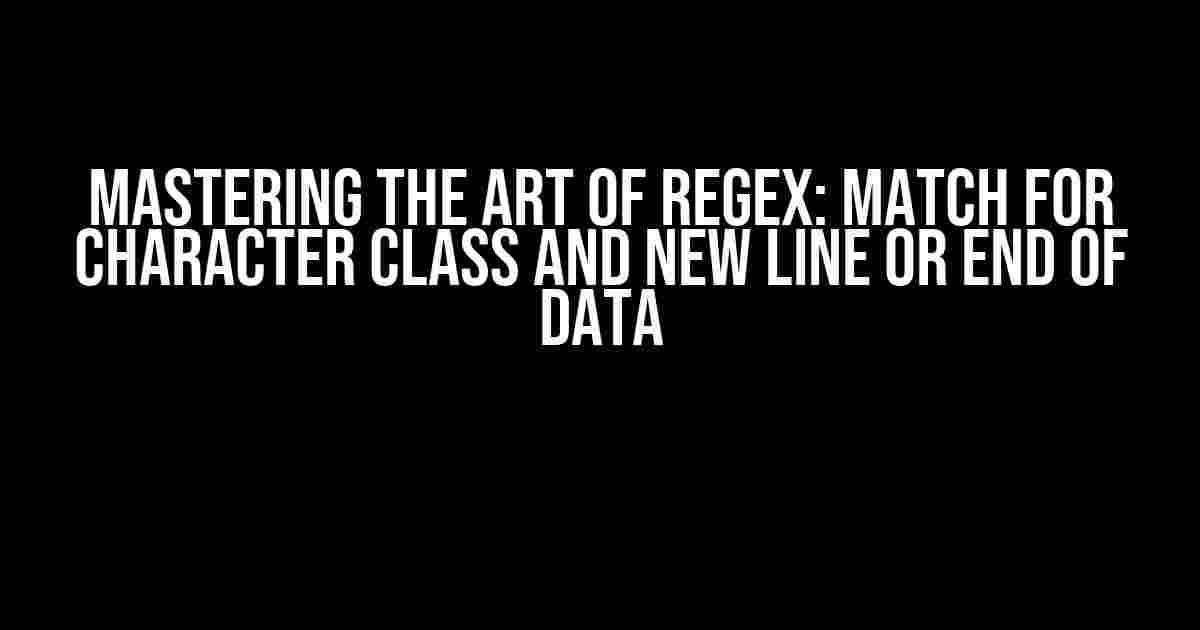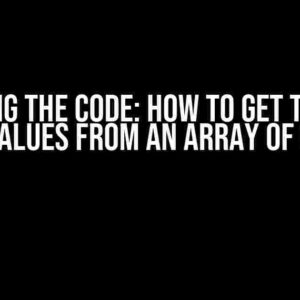Regular Expressions, commonly referred to as Regex, can be a daunting topic for many developers. However, with the right approach and guidance, it can become a powerful tool in your coding arsenal. In this in-depth article, we’ll explore the regex match for character class and new line or end of data, providing you with a comprehensive understanding of this crucial concept.
- What is a Character Class?
- The New Line (`\n`) and End of Data (`
Regular Expressions, commonly referred to as Regex, can be a daunting topic for many developers. However, with the right approach and guidance, it can become a powerful tool in your coding arsenal. In this in-depth article, we’ll explore the regex match for character class and new line or end of data, providing you with a comprehensive understanding of this crucial concept.
) Anchors
- New Line Character (`\n`)
- End of Data (`
Regular Expressions, commonly referred to as Regex, can be a daunting topic for many developers. However, with the right approach and guidance, it can become a powerful tool in your coding arsenal. In this in-depth article, we’ll explore the regex match for character class and new line or end of data, providing you with a comprehensive understanding of this crucial concept.
) Anchor
- Regex Match for Character Class and New Line or End of Data
- Common Use Cases
- Conclusion
What is a Character Class?
A character class in regex is a set of characters enclosed within square brackets `[]`. It’s used to match any single character within the set. For example, the character class `[abc]` would match any of the characters ‘a’, ‘b’, or ‘c’.
Common Character Classes
Here are some common character classes you should know:
- `[a-z]`: matches any lowercase letter
- `[A-Z]`: matches any uppercase letter
- `[0-9]`: matches any digit
- `[a-zA-Z0-9]`: matches any alphanumeric character
- `[\w]`: matches any word character (alphanumeric plus underscore)
- `[\W]`: matches any non-word character
The New Line (`\n`) and End of Data (`$`) Anchors
In regex, the new line character is represented by `\n`, while the end of data is represented by the `$` anchor.
New Line Character (`\n`)
The new line character is used to match the end of a line. It’s essential in multi-line strings where you want to match specific characters or patterns at the beginning or end of a line.
const regex = /\n$/; // matches the end of a line
const string = "Hello\nWorld";
console.log(string.match(regex)); // Output: ["\n"]
End of Data (`$`) Anchor
The `$` anchor is used to match the end of the string. It ensures that the pattern is matched at the very end of the input string.
const regex = /regex$/; // matches the string "regex" at the end of the string
const string = "Learn regex";
console.log(string.match(regex)); // Output: ["regex"]
Regex Match for Character Class and New Line or End of Data
Now that we’ve covered character classes and the new line and end of data anchors, let’s explore how to combine them to create powerful regex patterns.
Matching a Character Class at the End of a Line
To match a character class at the end of a line, you can use the following regex pattern:
const regex = /[abc]\n$/; // matches any of the characters 'a', 'b', or 'c' at the end of a line
const string = "Hello a\nWorld";
console.log(string.match(regex)); // Output: ["a\n"]
Matching a Character Class at the End of the String
To match a character class at the end of the string, you can use the following regex pattern:
const regex = /[abc]$/; // matches any of the characters 'a', 'b', or 'c' at the end of the string
const string = "Hello abc";
console.log(string.match(regex)); // Output: ["abc"]
Common Use Cases
Regex match for character class and new line or end of data has numerous use cases in real-world applications:
- Validating input data: You can use regex to validate user input, ensuring that it meets specific criteria, such as matching a certain format or pattern.
- Parsing log files: Regex can be used to extract specific information from log files, such as error messages or user activity.
- Data scraping: Regex is often used in data scraping to extract specific data from websites, such as prices, names, or addresses.
- String manipulation: Regex can be used to perform complex string manipulation tasks, such as replacing or extracting specific patterns.
Conclusion
Mastering the regex match for character class and new line or end of data is an essential skill for any developer. By understanding how to combine character classes with the new line and end of data anchors, you can create powerful regex patterns that solve complex problems. Remember to practice and experiment with different regex patterns to solidify your knowledge.
| Regex Pattern | Description |
|---|---|
| `[abc]` | Matches any of the characters ‘a’, ‘b’, or ‘c’ |
| `\n` | Matches the new line character |
| `$` | Matches the end of the string |
| `[abc]\n$` | Matches any of the characters ‘a’, ‘b’, or ‘c’ at the end of a line |
| `[abc]$` | Matches any of the characters ‘a’, ‘b’, or ‘c’ at the end of the string |
By applying the concepts learned in this article, you’ll be able to tackle complex regex tasks with confidence. Remember to stay creative and experiment with different regex patterns to unlock the full potential of this powerful tool.
Frequently Asked Question
Get ready to master the art of regex matching for character class and new line or end of data! Here are the answers to your most pressing questions.
How do I match a character class and a new line or end of data in regex?
You can use the `$` anchor to match the end of the string, and the `[\n\r]` character class to match a new line character. For example, the regex `[a-zA-Z]+[\n\r]*$` matches one or more letters followed by zero or more new line characters at the end of the string.
What is the difference between `\z` and `$` anchors in regex?
The `$` anchor matches the end of the string, while the `\z` anchor matches the end of the entire input, including any trailing new line characters. For example, the regex `foo$` matches the string “foo\n”, while the regex `foo\z` does not.
How do I match a character class and a new line or end of data in regex, but only if it’s not followed by another character?
You can use a negative lookahead assertion to ensure that the character class is not followed by another character. For example, the regex `[a-zA-Z]+(?![\s\S])` matches one or more letters, but only if they are not followed by another character.
What is the best way to match a new line or end of data in regex when working with multi-line strings?
When working with multi-line strings, it’s often best to use the `(?m)` modifier at the beginning of the regex pattern, which enables multi-line mode. This allows the `^` and `$` anchors to match the start and end of individual lines, rather than the entire string.
Can I use the `\A` and `\Z` anchors to match the start and end of the entire input in regex?
Yes, the `\A` anchor matches the start of the entire input, and the `\Z` anchor matches the end of the entire input, including any trailing new line characters. These anchors are similar to `^` and `$`, but are not affected by the `(?m)` modifier.




